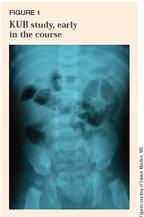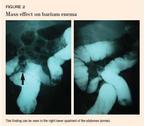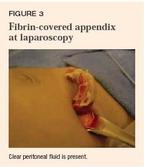Pediatric Puzzler: Vomiting and abdominal discomfort
Grunting, hot, and vomiting:What's the bother in Baby's belly?
PEDIATRIC PUZZLER
GEORGE K. SIBERRY, MD, MPH, SECTION EDITOR
Grunting, hot, and vomiting:
What's the bother in Baby's belly?
Susan Hayden, MD, and David Dorfman, MD
This account of an ill 6-month-old boy began earlier todayabout noon, before you became involvedwhen his concerned mother brought the infant to an urgent care center with complaints of fever and vomiting. He had had a cough and runny nose for one week, she reported, but this morning was different: several episodes of nonbloody, nonbilious vomiting. The physician on duty at the center recorded an axillary temperature of 102º F and noted that the boy appeared irritable and was grunting. She referred Mother and child to your emergency room.
Now, in the afternoon in the ER, you obtain a more thorough history from the mother. Her son has been sleepier than usual, hasn't been drinking well for two days, and has urinated only once today. He is not making tears when he cries. He has not had diarrheain fact, he hasn't passed a stool for three days. Mother has not sensed that he was in any abdominal pain until today; now, it seems to her, "his belly is bothering him." At home is a 2-year-old sister, also with a runny nose and a cough for two weeks. Both children attend day care.
This baby was delivered at term by cesarean section because of fetal distress; heart tones were lost briefly during labor. Birth weight was eight pounds. He has been exclusively bottlefed. He rolled at four months, sat at six, and recently started babbling. He has not been hospitalized or undergone surgery, is not taking any medications, and has no known allergies. Immunizations (including pneumococcal conjugate vaccine) are up to date.
The infant's only ongoing medical problem has been constipation. Usually, he has a bowel movement every two or three days, Mother reports; sometimes, a week goes by without his passing a stool, after which he has an "explosive" bowel movement. She also senses that passing those stools causes him pain.
On examination, the child appears fussy, but is consolable. He is grunting intermittentlyless when his mother holds him in a standing position and more when he is held in a sitting position. Rectal temperature is 102.2° F; heart rate, 184/min; respirations, 30/min; blood pressure, 90/40 mm Hg; and oxygen saturation, 99%.
The anterior fontanelle is open, soft, and flat. Mucous membranes are tacky. Ears appear normal, the neck is supple, and the chest is clear. The cardiovascular exam is notable for tachycardia without murmur. Peripheral pulses are strong; capillary refill is two seconds. Bowel sounds are present but decreased. The abdomen is soft and undistended but somewhat tender. Sphincter tone is normal and stool is guaiac negative.
Hoof beats, horses . . . what was that advice?
At this point, you are evaluating an ill-appearing, febrile, vomiting infant who is intermittently grunting and moderately dehydrated. You recall what you learned in medical school: An atypical presentation of an extremely common illness is more common than a typical presentation of a rare illness. The history is probably consistent with viral gastroenteritis, which certainly is common. But you are bothered by the absence of diarrhea, the child's ill appearance, and the grunting, so, in assembling an initial differential diagnosis, you also consider sepsis, pneumonia, and an intraabdominal process. The only localizing symptom is abdominal tenderness. The history of constipation coupled with explosive stooling could suggest Hirschsprung disease.
You place an intravenous line and order lab tests and blood cultures. The child is given a bolus of normal saline and IV fluids are started at one and a half times maintenance. Lab results arrive but only add to the puzzle: The white blood cell count is surprisingly low at 2.4 x 103/µL, with 30% neutrophils, 1% bands, 63% lymphocytes, and 6% monocytes. The hematocrit is low at 31%, with the mean corpuscular volume, 74. Platelets are normal at 288 x 103/µL. Electrolytes are reassuringly normal. Serum bicarbonate is 24 mmol/L; blood urea nitrogen, 10 mg/dL; and creatinine, 0.2 mg/dL. Urinalysis performed on a catheterized specimen is trace-positive for blood, without evidence of WBCs or nitrites.
You are still concerned about a potential pneumonia or an abdominal process, but initial radiographs don't help much. The chest film is normal, without infiltrate. A series of KUB studies in the supine, prone, and left lateral decubitus positions shows gas throughout the abdomen and into the rectum, with filling of the ascending and transverse colon, findings that make intussusception less likely. There is copious stool in the proximal colon but no dilation that would suggest Hirschsprung disease (Figure 1).

You are concerned enough about the child's degree of illness to perform a lumbar puncture, which reveals one lymphocyte and two RBCs (per microliter) in the cerebrospinal fluid; glucose and protein levels are normal. You order IV ceftriaxone, 50 mg/kg.
Still you wonder about an intraabdominal processgiven the focality of the examso you consult a pediatric surgeon. His initially worry is intussusception versus gastroenteritis, and so he recommends IV antibiotics, IV hydration, and a barium enema.
During the long period in which the child remains in the ED, however, his condition improves markedly with IV hydration. He stops grunting, becomes much less fussy, tolerates multiple abdominal exams, and is smiling and responsive. You decide to forego the barium enema and admit the child for observation, serial examinations, and IV hydration with a presumptive diagnosis of viral gastroenteritis.
But what if it is a zebra?
By the time you reexamine the baby when he arrives on the floor, however, he seems to have deteriorated. Temperature is 101.2° F; heart rate, 178/min; blood pressure, 83/43 mm Hg; and respirations, 56/min. He appears listless and does not interact with his mother or the examiner. Mucous membranes are moist and peripheral perfusion appears fine, but he is persistently tachycardic. The chest is clear, but he is tachypneic. He has hypoactive bowel sounds and his abdomen is diffusely tender. He demonstrates some voluntary guarding and is very irritable on examination. A genital exam is unremarkablehe is circumcised, with normal testes and no apparent hernias. On rectal exam, he has normal sphincter tone with stool palpable in the vault. His stool is guaiac negative. He does not have skin lesions.
Because the child's condition has now deteriorated clinically, your concern that he has an intussusception is renewed and you order a barium enema. The test shows good filling of the entire colon, which reassures you (Figure 2). The radiologist detects a mass effect in the right lower quadrant, however, and a follow-up abdominal sonogram reveals that there is a nondistensible loop of bowel and free fluid in the abdomen. You notify the surgeon and order a preoperative dose of IV piperacillin and tazobactam.

At laparoscopy, the infant's appendix is adult-sized (Figure 3), and so is removed. It is covered in fibrin, suggesting microperforation, but is not grossly perforated. The peritoneal fluid is clear. The child tolerates the procedure well and is discharged home on the fourth hospital day without complications.

Rare finding in early youth
Appendicitis is rare before 2 years of age. In a recent study of more than 3,000 consecutive cases of appendicitis in children, fewer than 3% of cases were seen in children younger than 2 years and fewer than 1% in children younger than 1 year.1 Neonatal appendicitis is rare but not unheard ofespecially in premature infants. Because it is rare and symptoms are nonspecific, infantile appendicitis is often misdiagnosed initially (time to diagnosis is, on average, four days). Common misdiagnoses include gastroenteritis, urinary tract infection, pneumonia, and bowel obstruction2 (Table 1). Common presenting symptoms are listed in Table 2. In this child, your concern about intussusception was appropriate; the condition has an incidence of 1.5 to 4 for every 1,000 live births, male predominance, and peak incidence between 5 and 9 months of age.3
TABLE 1
Differential diagnosis of acute abdomen in an infant
TABLE 2
Common findings in infantile appendicitis
The incidence of perforated appendicitis is much higher in infants than it is in older children, probably because the diagnosis is delayed in infants. The reported rate of appendiceal perforation in infants ranges from 70% to 95%, compared to a rate of 10% to 20% in older children.46 Perforation is associated with significant postoperative morbidity, independent of age. Complications include major abscess that requires operative or percutaneous drainage, phlegmon, enterocutaneous fistula, peritonitis, and partial bowel obstruction.7
To sum up: Appendicitis in infants is rare and often difficult to diagnose, but is an important element of the differential diagnosis. Keeping this condition in mind may minimize delay in diagnosis and reduce the likelihood of perforation and associated morbidity. What transpired with this patient illustrates how important it is to broaden and revise the differential diagnosis to include a zebra when an infant looks particularly ill and something in the presentation just doesn't fit, or feel right about, a common diagnosis like gastroenteritis. And that can make all the difference, because Baby just isn't going to tell you what's in his belly!
REFERENCES
1. Kokoska ER, Minkes RK, Silen ML, et al: Effect of pediatric surgical practice on the treatment of children with appendicitis. Pediatrics 2001;107:1298
2. Rothrock SG, Pagane J: Acute appendicitis in children: Emergency department diagnosis and management. Ann Emerg Med 2000;36:39
3. Irish MS, Pearl RH, Caty MG, et al: The approach to common abdominal diagnoses in infants and children. Pediatr Clin North Am 1998;45:729
4. Barker AP, Davey RV: Appendicitis in the first three years of life. Aust N Z J Surg 1988;58:491
5. Grosfeld JL, Weinberger M, Clatworthy HW: Acute appendicitis in the first two years of life. J Pediatr Surg 1973;8:285
6. Horwitz JR, Gursoy M, Jaksic T, et al: Importance of diarrhea as a presenting symptom of appendicitis in very young children. Am J Surg 1997;173:80
7. Pearl RH, Hale DA, Molloy M, et al: Pediatric appendectomy. J Pediatr Surg 1995;30:173
DR. HAYDEN is a third-year resident in the Boston Combined Residency Program, Harvard University School of Medicine, Cambidge, Mass.
DR. DORFMAN is an associate professor in the division of pediatric emergency medicine, Boston Medical Center, Boston, Mass.
DR. SIBERRY is a fellow in pediatric infectious disease at The Johns Hopkins Hospital, Baltimore, Md.
Some of our most satisfying moments in pediatricsand some of our best clinical pearlsresult from solving perplexing cases. If you have a favorite, send it to
The Editors
Contemporary Pediatrics
5 Paragon Drive Montvale, NJ 07645
If it is used, you will be cited as the contributor.
George Siberry, ed. Susan Hayden, David Dorfman. Pediatric Puzzler: Vomiting and abdominal discomfort.
Contemporary Pediatrics
2002;12:21.